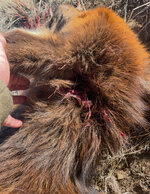My post is very clearly written. You brought up 1800 fps. Yes quartering away or in require more penetration than broadside. You are the one pushing the 223 for all hunting. You brought up "all the people" who have been successful in doing so. If BC is so important to you then why is SD not?
Yes, I brought up a minimum impact velocity to achieve the bullet performance that I am comfortable with when it comes to killing. I fully believe that someone who has a solid understanding of how their chosen bullet behaves in flesh at various impact velocities is a more effective hunter.
I’m not pushing a 223 for anything, to anyone. I’m merely relating my specific experiences with various cartridges and specific bullets across an array of animals, and what I have found to be an effective and efficient combination when it comes to killing. Shoot whatever you like, I care not. I WILL however point out that some bullets kill faster and more decisively than others, regardless of diameter.
BC isn’t important to me. At all. It’s merely a unit of measure that tells me where my minimum velocity threshold will occur, and how much my bullet of choice can be moved by wind. I need to know what it is so that I can figure out where my performance window ends, but thats about the extent of it.
The construction of the bullet IS important to me - I like how the long nose of the ELD m has a lot of material to crumple and create debris inside the animal, while the long shank keeps penetrating even as it is expanding and fragmenting. That it has a high bc and retains velocity quite well is all a secondary benefit to how it performs on game. Just means I can push the distance out in windier conditions than I could with a short stubby bullet.
SD as a unit of measure is basically meaningless for my purposes as it doesn’t take bullet construction into account. I already KNOW that a Barnes .308” 168 TSX will penetrate deeper more reliably than a 168 Sierra Match King, yet they have the exact same SD.
I recognize that SD is a calculable number, but it doesn’t really mean anything to me. It’s merely an anecdotal piece of information.
No different than figuring out how much energy my daily driver BMW is carrying when I’m doing 150 kph on the highway- it’s a number, and it can be calculated, but it doesn’t really mean anything in the way it is being used.


